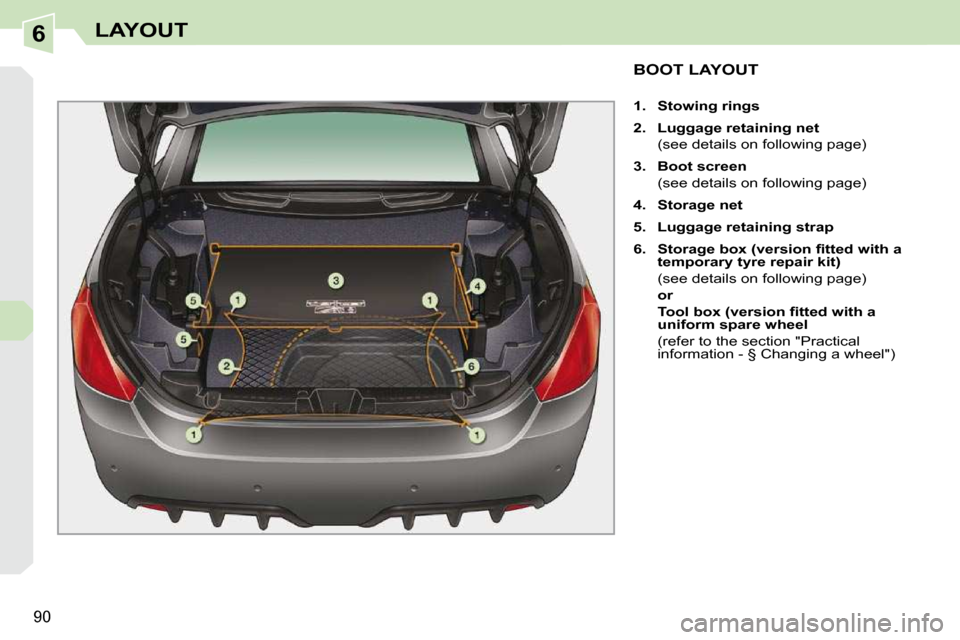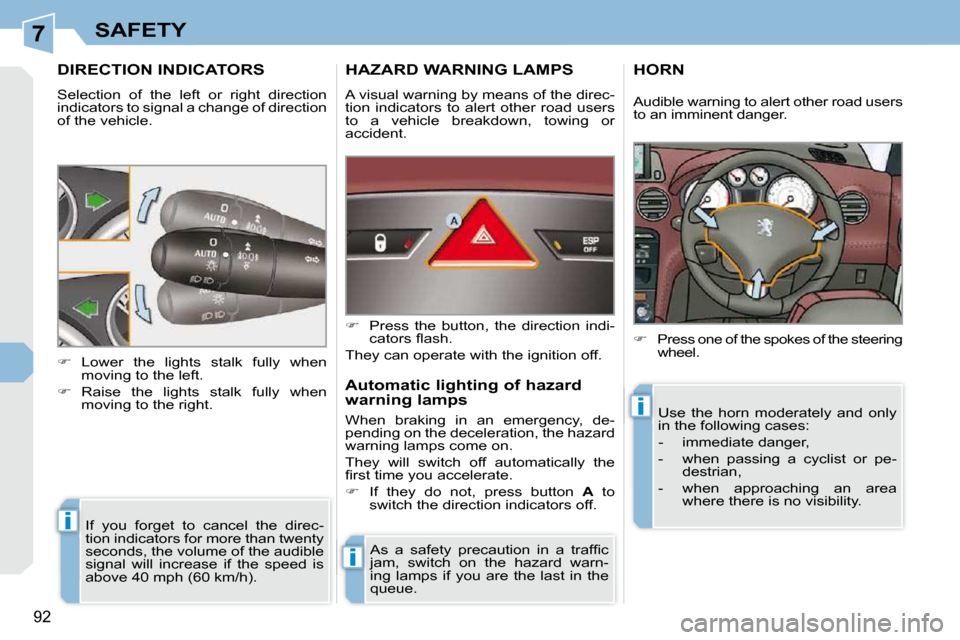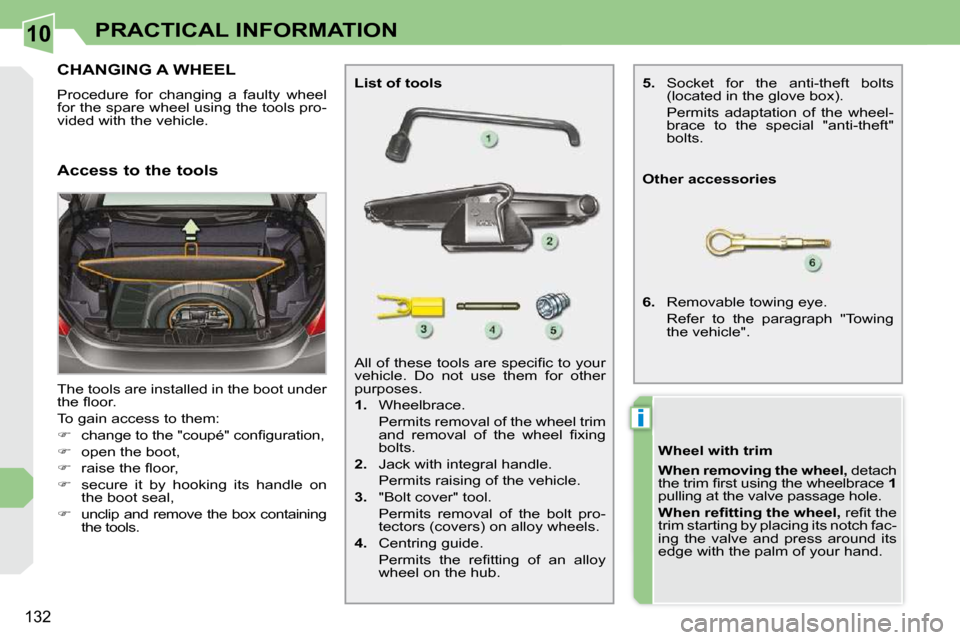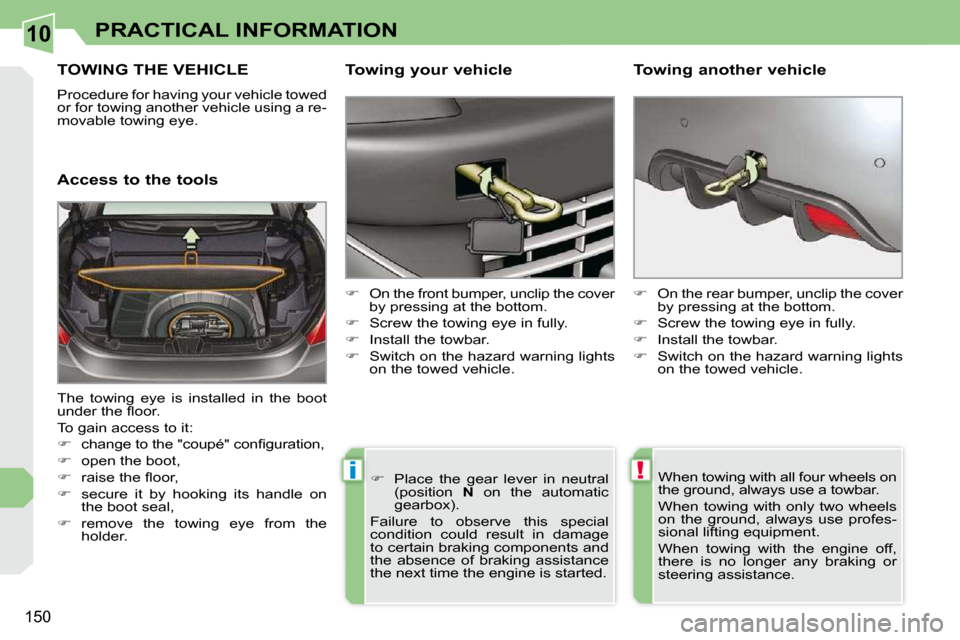2009 Peugeot 308 CC towing
[x] Cancel search: towingPage 44 of 294

3
i
47
COMFORT
The air conditioning system does
not contain chlorine and does not
present any danger to the ozone
layer. RECOMMENDATIONS FOR VENTILATION AND AIR CONDITIONING
In order for these systems to be fully effective, follow the operation and main-
tenance rules below:
� If the interior temperature remains very high after the vehicle has been
parked in the sun for a considerable time, do not hesitate t o ventilate the
passenger compartment for a few minutes.
� �P�l�a�c�e� �t�h�e� �a�i�r� �fl� �o�w� �c�o�n�t�r�o�l� �a�t� �a� �s�u�f�fi� �c�i�e�n�t� �l�e�v�e�l� �t�o� �p�r�o�v�i�d�e� �a�n� �a�d�e�q�u�a�t�e�
renewal of air in the passenger compartment.
� To obtain an even air distribution, take care not to obst ruct the exterior air
intake grilles located at the base of the windscreen, the n ozzles, the vents
and the air outlets, as well as the air extractor located in the boot.
� Do not cover the sunshine sensor, located on the fascia; th is is used for
regulation of the air conditioning system.
� Operate the air conditioning system for 5 to 10 minutes, on ce or twice a
month to keep it in perfect working order.
� � � �E�n�s�u�r�e� �t�h�a�t� �t�h�e� �p�a�s�s�e�n�g�e�r� �c�o�m�p�a�r�t�m�e�n�t� �fi� �l�t�e�r� �i�s� �i�n� �g�o�o�d� �c�o�n�d�i�t �i�o�n� �a�n�d�
�h�a�v�e� �t�h�e� �fi� �l�t�e�r� �e�l�e�m�e�n�t�s� �r�e�p�l�a�c�e�d� �r�e�g�u�l�a�r�l�y� �(�r�e�f�e�r� �t�o� �t�h�e� �"�C�h�e�c�k�s�"� �s�e�c�t�i�o�n�)�.�
� � � �W�e� �r�e�c�o�m�m�e�n�d� �t�h�e� �u�s�e� �o�f� �a� �c�o�m�b�i�n�e�d� �p�a�s�s�e�n�g�e�r� �c�o�m�p�a�r�t�m�e�n�t� �fi� �l�t�e�r �.�
�T�h�a�n�k�s� �t�o� �i�t�s� �s�e�c�o�n�d� �s�p�e�c�i�a�l� �a�c�t�i�v�e� �fi� �l�t�e�r�,� �i�t� �c�o�n�t�r�i�b�u�t�e�s� �t�o� �t �h�e� �p�u�r�i�fi� �c�a�t�i�o�n�
of the air breathed by the occupants and the cleanness of th e passenger
compartment (reduction of allergic symptoms, bad odours and greasy de-
posits).
� To guarantee correct operation of the air conditioning syste m, you are also
advised to have it checked regularly.
� If the system does not produce cold air, do not use it and contact a
PEUGEOT dealer.
� �I�n� �t�h�e� �"�c�a�b�r�i�o�l�e�t�"� �c�o�n�fi� �g�u�r�a�t�i�o�n�,� �i�n�s�t�a�l�l�i�n�g� �t�h�e� �w�i�n�d�s�t�o�p� �a�n�d� �u�s�i�n�g� �t�h�e� �"�A�I�R�W�A�V�E�"� systems improves comfort.
When towing the maximum load on a steep gradient in high temperatures,
switching off the air conditioning permits the recovery of engi ne power and
therefore improvement of the towing capacity.
The condensation created by the air conditioning results in a discharge of
water under the vehicle which is perfectly normal.
Page 102 of 294

6
90
LAYOUT
BOOT LAYOUT
1. Stowing rings
2. Luggage retaining net
(see details on following page)
3. Boot screen
(see details on following page)
4. Storage net
5. Luggage retaining strap
6. �S�t�o�r�a�g�e� �b�o�x� �(�v�e�r�s�i�o�n� �fi� �t�t�e�d� �w�i�t�h� �a�
temporary tyre repair kit)
(see details on following page)
or
�T�o�o�l� �b�o�x� �(�v�e�r�s�i�o�n� �fi� �t�t�e�d� �w�i�t�h� �a�
uniform spare wheel
(refer to the section "Practical �i�n�f�o�r�m�a�t�i�o�n� �-� �§� �C�h�a�n�g�i�n�g� �a� �w�h�e�e�l�"�)� �
Page 104 of 294

7
i
i
i
92
SAFETY
DIRECTION INDICATORS
Selection of the left or right direction
indicators to signal a change of direction
of the vehicle. If you forget to cancel the direc-
tion indicators for more than twenty
seconds, the volume of the audible
signal will increase if the speed is
above 40 mph (60 km/h).
� Lower the lights stalk fully when
moving to the left.
� Raise the lights stalk fully when moving to the right.
HAZARD WARNING LAMPS
A visual warning by means of the direc-
tion indicators to alert other road users
to a vehicle breakdown, towing or
accident.
� �A�s� �a� �s�a�f�e�t�y� �p�r�e�c�a�u�t�i�o�n� �i�n� �a� �t�r�a�f�fi� �c�
jam, switch on the hazard warn-
ing lamps if you are the last in the
queue.
� Press the button, the direction indi-
�c�a�t�o�r�s� �fl� �a�s�h�.� �
They can operate with the ignition off.
Automatic lighting of hazard
warning lamps
When braking in an emergency, de-
pending on the deceleration, the hazard
warning lamps come on.
They will switch off automatically the
�fi� �r�s�t� �t�i�m�e� �y�o�u� �a�c�c�e�l�e�r�a�t�e�.�
� If they do not, press button A to
switch the direction indicators off.
HORN
� Press one of the spokes of the steering
wheel.
Use the horn moderately and only
in the following cases:
- immediate danger,
- when passing a cyclist or pe- destrian,
- when approaching an area where there is no visibility.
Audible warning to alert other road users
to an imminent danger.
Page 146 of 294

10
i
132
PRACTICAL INFORMATION
CHANGING A WHEEL
Procedure for changing a faulty wheel
�f�o�r� �t�h�e� �s�p�a�r�e� �w�h�e�e�l� �u�s�i�n�g� �t�h�e� �t�o�o�l�s� �p�r�o�-
�v�i�d�e�d� �w�i�t�h� �t�h�e� �v�e�h�i�c�l�e�.�
The tools are installed in the boot under
�t�h�e� �fl� �o�o�r�.�
� �T�o� �g�a�i�n� �a�c�c�e�s�s� �t�o� �t�h�e�m�:�
� � � �c�h�a�n�g�e� �t�o� �t�h�e� �"�c�o�u�p�é�"� �c�o�n�fi� �g�u�r�a�t�i�o�n�,�
� � � �o�p�e�n� �t�h�e� �b�o�o�t�,�
� � � �r�a�i�s�e� �t�h�e� �fl� �o�o�r�,�
� secure it by hooking its handle on
�t�h�e� �b�o�o�t� �s�e�a�l�,�
� � � �u�n�c�l�i�p� �a�n�d� �r�e�m�o�v�e� �t�h�e� �b�o�x� �c�o�n�t�a�i�n�i�n�g�
�t�h�e� �t�o�o�l�s�.� � � �A�l�l� �o�f� �t�h�e�s�e� �t�o�o�l�s� �a�r�e� �s�p�e�c�i�fi� �c� �t�o� �y�o�u�r�
�v�e�h�i�c�l�e�.� �D�o� �n�o�t� �u�s�e� �t�h�e�m� �f�o�r� �o�t�h�e�r�
�p�u�r�p�o�s�e�s�.�
1. � � �W�h�e�e�l�b�r�a�c�e�.� �
� �P�e�r�m�i�t�s� �r�e�m�o�v�a�l� �o�f� �t�h�e� �w�h�e�e�l� �t�r�i�m� �a�n�d� �r�e�m�o�v�a�l� �o�f� �t�h�e� �w�h�e�e�l� �fi� �x�i�n�g�
�b�o�l�t�s�.�
2. � � �J�a�c�k� �w�i�t�h� �i�n�t�e�g�r�a�l� �h�a�n�d�l�e�.� �
� �P�e�r�m�i�t�s� �r�a�i�s�i�n�g� �o�f� �t�h�e� �v�e�h�i�c�l�e�.�
3. � � �"�B�o�l�t� �c�o�v�e�r�"� �t�o�o�l�.� �
� �P�e�r�m�i�t�s� �r�e�m�o�v�a�l� �o�f� �t�h�e� �b�o�l�t� �p�r�o�- �t�e�c�t�o�r�s� �(�c�o�v�e�r�s�)� �o�n� �a�l�l�o�y� �w�h�e�e�l�s�.�
4. � � �C�e�n�t�r�i�n�g� �g�u�i�d�e�.� �
� �P�e�r�m�i�t�s� �t�h�e� �r�e�fi� �t�t�i�n�g� �o�f� �a�n� �a�l�l�o�y� �w�h�e�e�l� �o�n� �t�h�e� �h�u�b�.�
List of tools
Other accessories
6. � � �R�e�m�o�v�a�b�l�e� �t�o�w�i�n�g� �e�y�e�.�
Refer to the paragraph "Towing �t�h�e� �v�e�h�i�c�l�e�"�.� �
Access to the tools
Wheel with trim
When removing the wheel
, detach
�t�h�e� �t�r�i�m� �fi� �r�s�t� �u�s�i�n�g� �t�h�e� �w�h�e�e�l�b�r�a�c�e� � 1
�p�u�l�l�i�n�g� �a�t� �t�h�e� �v�a�l�v�e� �p�a�s�s�a�g�e� �h�o�l�e�.�
�W�h�e�n� �r�e�fi� �t�t�i�n�g� �t�h�e� �w�h�e�e�l
, � �r�e�fi� �t� �t�h�e�
�t�r�i�m� �s�t�a�r�t�i�n�g� �b�y� �p�l�a�c�i�n�g� �i�t�s� �n�o�t�c�h� �f�a�c�-
�i�n�g� �t�h�e� �v�a�l�v�e� �a�n�d� �p�r�e�s�s� �a�r�o�u�n�d� �i�t�s�
�e�d�g�e� �w�i�t�h� �t�h�e� �p�a�l�m� �o�f� �y�o�u�r� �h�a�n�d�.� � �
5. � � �S�o�c�k�e�t� �f�o�r� �t�h�e� �a�n�t�i�-�t�h�e�f�t� �b�o�l�t�s�
�(�l�o�c�a�t�e�d� �i�n� �t�h�e� �g�l�o�v�e� �b�o�x�)�.� �
� �P�e�r�m�i�t�s� �a�d�a�p�t�a�t�i�o�n� �o�f� �t�h�e� �w�h�e�e�l�- �b�r�a�c�e� �t�o� �t�h�e� �s�p�e�c�i�a�l� �"�a�n�t�i�-�t�h�e�f�t�"�
�b�o�l�t�s�.� � �
Page 165 of 294

10
!i
150
PRACTICAL INFORMATION
TOWING THE VEHICLE
� �P�r�o�c�e�d�u�r�e� �f�o�r� �h�a�v�i�n�g� �y�o�u�r� �v�e�h�i�c�l�e� �t�o�w�e�d�
�o�r� �f�o�r� �t�o�w�i�n�g� �a�n�o�t�h�e�r� �v�e�h�i�c�l�e� �u�s�i�n�g� �a� �r�e�-
�m�o�v�a�b�l�e� �t�o�w�i�n�g� �e�y�e�.�
Access to the tools Towing your vehicle
� � � �O�n� �t�h�e� �f�r�o�n�t� �b�u�m�p�e�r�,� �u�n�c�l�i�p� �t�h�e� �c�o�v�e�r�
�b�y� �p�r�e�s�s�i�n�g� �a�t� �t�h�e� �b�o�t�t�o�m�.�
� � � �S�c�r�e�w� �t�h�e� �t�o�w�i�n�g� �e�y�e� �i�n� �f�u�l�l�y�.�
� � � �I�n�s�t�a�l�l� �t�h�e� �t�o�w�b�a�r�.�
� Switch on the hazard warning lights
�o�n� �t�h�e� �t�o�w�e�d� �v�e�h�i�c�l�e�.�
� � � �O�n� �t�h�e� �r�e�a�r� �b�u�m�p�e�r�,� �u�n�c�l�i�p� �t�h�e� �c�o�v�e�r�
�b�y� �p�r�e�s�s�i�n�g� �a�t� �t�h�e� �b�o�t�t�o�m�.�
� � � �S�c�r�e�w� �t�h�e� �t�o�w�i�n�g� �e�y�e� �i�n� �f�u�l�l�y�.�
� � � �I�n�s�t�a�l�l� �t�h�e� �t�o�w�b�a�r�.�
� Switch on the hazard warning lights
�o�n� �t�h�e� �t�o�w�e�d� �v�e�h�i�c�l�e�.� �
Towing another vehicle
The towing eye is installed in the boot
�u�n�d�e�r� �t�h�e� �fl� �o�o�r�.�
� �T�o� �g�a�i�n� �a�c�c�e�s�s� �t�o� �i�t�:�
� � � �c�h�a�n�g�e� �t�o� �t�h�e� �"�c�o�u�p�é�"� �c�o�n�fi� �g�u�r�a�t�i�o�n�,�
� � � �o�p�e�n� �t�h�e� �b�o�o�t�,�
� � � �r�a�i�s�e� �t�h�e� �fl� �o�o�r�,�
� secure it by hooking its handle on
�t�h�e� �b�o�o�t� �s�e�a�l�,�
� � � �r�e�m�o�v�e� �t�h�e� �t�o�w�i�n�g� �e�y�e� �f�r�o�m� �t�h�e�
�h�o�l�d�e�r�.� � � When towing with all four wheels on
�t�h�e� �g�r�o�u�n�d�,� �a�l�w�a�y�s� �u�s�e� �a� �t�o�w�b�a�r�.�
When towing with only two wheels
�o�n� �t�h�e� �g�r�o�u�n�d�,� �a�l�w�a�y�s� �u�s�e� �p�r�o�f�e�s�-
�s�i�o�n�a�l� �l�i�f�t�i�n�g� �e�q�u�i�p�m�e�n�t�.�
� �W�h�e�n� �t�o�w�i�n�g� �w�i�t�h� �t�h�e� �e�n�g�i�n�e� �o�f�f�,�
there is no longer any braking or
�s�t�e�e�r�i�n�g� �a�s�s�i�s�t�a�n�c�e�.� �
� � � �P�l�a�c�e� �t�h�e� �g�e�a�r� �l�e�v�e�r� �i�n� �n�e�u�t�r�a�l�
(position N on the automatic
�g�e�a�r�b�o�x�)�.� �
�F�a�i�l�u�r�e� �t�o� �o�b�s�e�r�v�e� �t�h�i�s� �s�p�e�c�i�a�l�
condition could result in damage
to certain braking components and
the absence of braking assistance
�t�h�e� �n�e�x�t� �t�i�m�e� �t�h�e� �e�n�g�i�n�e� �i�s� �s�t�a�r�t�e�d�.� � �
Page 166 of 294

10
i
i
151
PRACTICAL INFORMATION
TOWING A TRAILER, A CARAVAN, ETC.
� �Y�o�u�r� �v�e�h�i�c�l�e� �i�s� �p�r�i�m�a�r�i�l�y� �d�e�s�i�g�n�e�d� �f�o�r�
�t�r�a�n�s�p�o�r�t�i�n�g� �p�e�o�p�l�e� �a�n�d� �l�u�g�g�a�g�e�,� �b�u�t� �i�t�
�m�a�y� �a�l�s�o� �b�e� �u�s�e�d� �f�o�r� �t�o�w�i�n�g� �a� �t�r�a�i�l�e�r�.� Distribution of loads
� Distribute the load in the trailer so
�t�h�a�t� �t�h�e� �h�e�a�v�i�e�s�t� �i�t�e�m�s� �a�r�e� �a�s� �c�l�o�s�e�
�a�s� �p�o�s�s�i�b�l�e� �t�o� �t�h�e� �a�x�l�e� �a�n�d� �t�h�e� �n�o�s�e�
�w�e�i�g�h�t� �a�p�p�r�o�a�c�h�e�s� �t�h�e� �m�a�x�i�m�u�m�
�p�e�r�m�i�t�t�e�d� �w�i�t�h�o�u�t� �e�x�c�e�e�d�i�n�g� �i�t�.� �
� �A�i�r� �d�e�n�s�i�t�y� �d�e�c�r�e�a�s�e�s� �w�i�t�h� �a�l�t�i�t�u�d�e�,� �t�h�u�s�
�r�e�d�u�c�i�n�g� �e�n�g�i�n�e� �p�e�r�f�o�r�m�a�n�c�e�.� �A�b�o�v�e�
�1� �0�0�0� �m�e�t�r�e�s�,� �t�h�e� �m�a�x�i�m�u�m� �t�o�w�i�n�g� �l�o�a�d�
must be reduced by 10 % and so on for
�e�v�e�r�y� �1� �0�0�0� �m�e�t�r�e�s� �o�f� �a�l�t�i�t�u�d�e�.�
Refer to the "Technical Data" section for
details of the weights and towing loads
�w�h�i�c�h� �a�p�p�l�y� �t�o� �y�o�u�r� �v�e�h�i�c�l�e�.� � � �I�n� �a�l�l� �c�a�s�e�s�,� �p�a�y� �a�t�t�e�n�t�i�o�n� �t�o� �t�h�e� �c�o�o�l�a�n�t�
�t�e�m�p�e�r�a�t�u�r�e�.�
Side wind
� Take into account the increased
�s�e�n�s�i�t�i�v�i�t�y� �t�o� �s�i�d�e� �w�i�n�d�.� � �
Cooling
Towing a trailer on a slope increases
�t�h�e� �t�e�m�p�e�r�a�t�u�r�e� �o�f� �t�h�e� �c�o�o�l�a�n�t�.�
� �A�s� �t�h�e� �f�a�n� �i�s� �e�l�e�c�t�r�i�c�a�l�l�y� �c�o�n�t�r�o�l�l�e�d�,� �i�t�s�
cooling capacity is not dependent on
�t�h�e� �e�n�g�i�n�e� �s�p�e�e�d�.�
� � � �T�o� �l�o�w�e�r� �t�h�e� �e�n�g�i�n�e� �s�p�e�e�d�,� �r�e�d�u�c�e�
�y�o�u�r� �s�p�e�e�d�.� � Braking
Towing a trailer increases the braking
�d�i�s�t�a�n�c�e�.� �
Tyres
� Check the tyre pressures of the towing
�v�e�h�i�c�l�e� �a�n�d� �o�f� �t�h�e� �t�r�a�i�l�e�r�,� �o�b�s�e�r�v�i�n�g� �t�h�e�
�r�e�c�o�m�m�e�n�d�e�d� �p�r�e�s�s�u�r�e�s�.� � �
Lighting
� Check the electrical signalling on
�t�h�e� �t�r�a�i�l�e�r�.� �
The rear parking assistance will
�b�e� �d�e�a�c�t�i�v�a�t�e�d� �a�u�t�o�m�a�t�i�c�a�l�l�y� �i�f� �a�n�
�o�r�i�g�i�n�a�l� �P�E�U�G�E�O�T� �t�o�w�b�a�r� �i�s� �u�s�e�d�.� � �
� � � �I�f� �t�h�e� �w�a�r�n�i�n�g� �l�a�m�p� �a�n�d� �t�h�e�
STOP warning lamp come
�o�n�,� �s�t�o�p� �t�h�e� �v�e�h�i�c�l�e� �a�n�d�
switch off the engine as
�s�o�o�n� �a�s� �p�o�s�s�i�b�l�e�.� � �
Towbar suited to the attachment of a
�t�r�a�i�l�e�r� �o�r� �c�a�r�a�v�a�n� �w�i�t�h� �a�d�d�i�t�i�o�n�a�l� �s�i�g�n�a�l�-
�l�i�n�g� �a�n�d� �l�i�g�h�t�i�n�g�.�
Driving advice
We recommend the use of genuine
�P�E�U�G�E�O�T� �t�o�w�b�a�r�s� �a�n�d� �t�h�e�i�r� �h�a�r�-
�n�e�s�s�e�s� �t�h�a�t� �h�a�v�e� �b�e�e�n� �t�e�s�t�e�d� �a�n�d�
�a�p�p�r�o�v�e�d� �f�r�o�m� �t�h�e� �d�e�s�i�g�n� �s�t�a�g�e�
�o�f� �y�o�u�r� �v�e�h�i�c�l�e�,� �a�n�d� �t�h�a�t� �t�h�e� �fi� �t�-
ting of the towbar is entrusted to a
�P�E�U�G�E�O�T� �d�e�a�l�e�r�.�
� �I�f� �t�h�e� �t�r�a�i�l�e�r� �i�s� �n�o�t� �fi� �t�t�e�d� �b�y� �a�
�P�E�U�G�E�O�T� �d�e�a�l�e�r�,� �i�t� �i�s� �i�m�p�e�r�a�t�i�v�e�
�t�h�a�t� �i�t� �i�s� �fi� �t�t�e�d� �u�s�i�n�g� �t�h�e� �e�l�e�c�t�r�i�c�a�l�
�p�r�e�-�e�q�u�i�p�m�e�n�t� �i�n�s�t�a�l�l�e�d� �a�t� �t�h�e� �r�e�a�r�
�o�f� �t�h�e� �v�e�h�i�c�l�e�,� �i�n� �a�c�c�o�r�d�a�n�c�e� �w�i�t�h�
�t�h�e� �m�a�n�u�f�a�c�t�u�r�e�r�'�s� �i�n�s�t�r�u�c�t�i�o�n�s�.� � �D�r�i�v�i�n�g� �w�i�t�h� �a� �t�r�a�i�l�e�r� �s�u�b�j�e�c�t�s� �t�h�e� �t�o�w�i�n�g�
�v�e�h�i�c�l�e� �t�o� �m�o�r�e� �s�i�g�n�i�fi� �c�a�n�t� �s�t�r�e�s�s� �a�n�d� �i�t�s�
�d�r�i�v�e�r� �m�u�s�t� �b�e� �p�a�r�t�i�c�u�l�a�r�l�y� �c�a�r�e�f�u�l�.� �
� �T�h�e� �m�a�x�i�m�u�m� �t�o�w�i�n�g� �l�o�a�d� �o�n� �a� �l�o�n�g�
slope depends on the gradient and the
�a�m�b�i�e�n�t� �t�e�m�p�e�r�a�t�u�r�e�.�
Page 174 of 294

11
156
TECHNICAL DATA
WEIGHTS AND TOWED LOADS (in kg)
Petrol engines
1.6 litre VTi 16V
120 bhp
1.6 litre THP 16V
150 bhp
1.6 litre THP 16V
140 bhp
Gearboxes
Manual Manual Auto.
Model codes: 4B... 5FS-C 5FX-H 5FT-F
- Unladen weight 1 480 1 512 1 523
- Kerb weight 1 555 1 587 1 598
- Payload 405 428 432
- Gross vehicle weight (GVW) 1 885 1 940 1 955
- Gross train weight (GVW)
on a 12 % gradient 2 985 3 340 3 225
- Braked trailer (within GTW limit)
on a 10 % or 12 % gradient 1 100 1 400 1 270
- Braked trailer * (with load transfer within GTW limit) 1 200 1 400 1 270
- Unbraked trailer 750 750 750
- Recommended nose weight 64 64 64
The GTW and towed load values indicated apply up to a maximum altitude of 1 000 metres; the towed load mentioned must
be reduced by 10 % for every additional 1 000 metres.
The speed of a towing vehicle must not exceed 60 mph (100 k m/h) (comply with the legislation in force in your country).
High exterior temperatures may result in a reduction in the perf ormance of the vehicle to protect the engine; when the exterior
temperature is higher than 37 °C, limit the towed weight.
* The weight of the braked trailer can be incr
eased, within the GTW limit, on condition that the GVW of the towing vehicle is reduced
by the same amount; warning: towing with a lightly loaded towing vehicle may have an adverse effect on its road holding.
Page 175 of 294

11
159
TECHNICAL DATA
* The weight of the braked trailer can be increased, within the GTW limit, on condition that the GVW of the towing vehicle is reduced by
the same amount; warning: towing with a lightly loa ded towing vehicle may have an adverse effect on it s road holding.
The GTW and towed load values indicated apply up to a maximum altitude of 1 000 metres; the towed load mentioned must
be reduced by 10 % for every additional 1 000 metres.
The speed of a towing vehicle must not exceed 60 mph (100 k m/h) (comply with the legislation in force in your country).
High exterior temperatures may result in a reduction in the perf ormance of the vehicle to protect the engine; when the exterior
temperature is higher than 37 °C, limit the towed weight.
WEIGHTS AND TOWED LOADS (in kg)
Diesel engines
1.6 litre Turbo HDI 16V
110 bhp
2 litre Turbo HDI 16V 136 bhp
Gearboxes
Manual Manual Auto.
Model codes: 4B... 9HR-H RHR-H RHR-J
- Unladen weight 1 525 1 599 1 620
- Kerb weight 1 600 1 674 1 695
- Payload 400 421 420
- Gross vehicle weight (GVW) 1 925 2 020 2 040
- Gross train weight (GTW)
on a 12 % gradient 3 025 3 420 3 440
- Braked trailer (within GTW limit)
on a 10 % or 12 % gradient 1 100 1 400 1 400
- Braked trailer * (with load transfer within GTW limit) 1 200 1 400 1 400
- Unbraked trailer 750 750 750
- Recommended nose weight 64 64 64